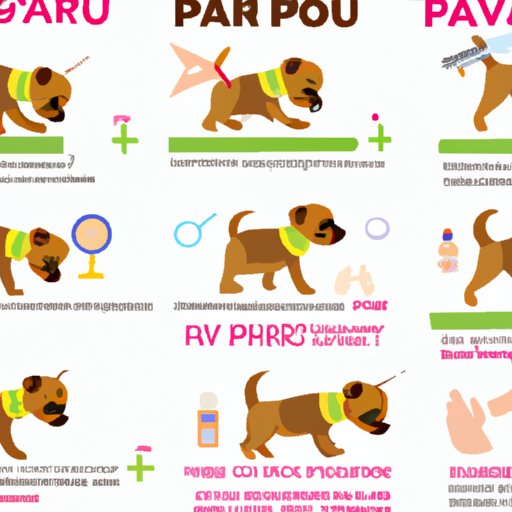Introduction
Parvo is a highly contagious virus that affects puppies and dogs of all ages. It is especially dangerous for puppies because their immune systems are not fully developed and they are more susceptible to infection. If left untreated, parvo can be fatal. In this article, we’ll discuss what parvo is, how puppies get it, signs and symptoms of parvo in puppies, prevention tips, and treatment options if your puppy does become infected.

Overview of Parvo and How it Affects Puppies
Canine parvovirus (CPV) is a viral infection that affects dogs and puppies. It is highly contagious and can be spread through contact with an infected dog or contaminated surfaces. According to the American Veterinary Medical Association, “CPV is shed in large amounts in the feces of infected dogs and can survive in the environment for long periods of time.”
Puppies are particularly vulnerable to parvo because their immune systems are not yet fully developed. The virus attacks the lining of the intestines, resulting in severe vomiting, diarrhea, dehydration, and electrolyte imbalances that can lead to death if left untreated. Parvo can also affect the heart and nervous system, causing long-term health issues even after the virus has been eradicated.

Signs and Symptoms of Parvo in Puppies
The most common signs and symptoms of parvo in puppies are vomiting, diarrhea, lethargy, loss of appetite, and fever. Puppies may also show signs of abdominal pain and dehydration, such as sunken eyes and dry gums. If you suspect your puppy has parvo, it’s important to take them to the vet right away so they can receive proper treatment.
Early detection and prevention are key when it comes to parvo. While there is no way to prevent parvo entirely, there are steps you can take to reduce your puppy’s risk of infection. Vaccinating your puppy against parvo is the best way to protect them from the virus. Additionally, keeping your puppy away from other dogs and areas where other dogs have been can help reduce the risk of infection.

Prevention Tips to Keep Your Puppy from Getting Parvo
Vaccinating your puppy is the best way to protect them from parvo. The American Veterinary Medical Association recommends vaccinating puppies at least twice, beginning at 6-8 weeks of age and then again at 10-12 weeks. After that, puppies should be vaccinated every year to maintain immunity.
In addition to vaccination, there are other methods you can use to protect your puppy from parvo. Keeping your puppy away from other dogs, especially those who are not vaccinated, is a good way to prevent the spread of the virus. You should also avoid taking your puppy to public places like dog parks, pet stores, and groomers until they have had their full series of vaccines. Additionally, always practice good hygiene and clean up after your puppy to prevent the spread of the virus.
What to Do if Your Puppy Gets Parvo
If your puppy does become infected with parvo, it is important to seek veterinary care immediately. Parvo is a serious, potentially life-threatening illness, so it’s important to get your puppy the medical attention they need as soon as possible. Treatment typically includes hospitalization, fluids, antibiotics, and other medications to help support your puppy’s recovery.
It’s also important to remember that parvo can cause long-term health issues, even after the virus has been eliminated. Your vet will likely recommend follow-up tests and treatments to ensure your puppy is healthy and strong. Additionally, providing your puppy with plenty of love and attention during their recovery can make a big difference in their overall health and wellbeing.
Conclusion
Parvo is a highly contagious virus that can be fatal to puppies. Early detection and prevention are key when it comes to protecting your puppy from the virus. Vaccinating your puppy and practicing good hygiene are the best ways to prevent parvo, while seeking immediate veterinary care is the best course of action if your puppy does become infected. With proper care and support, your puppy can make a full recovery.
(Note: Is this article not meeting your expectations? Do you have knowledge or insights to share? Unlock new opportunities and expand your reach by joining our authors team. Click Registration to join us and share your expertise with our readers.)
